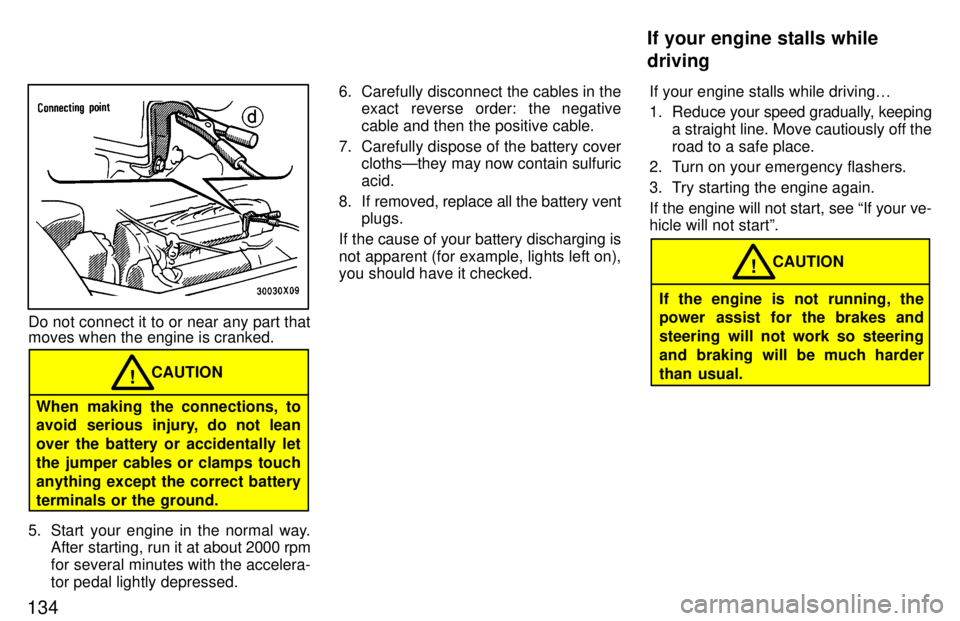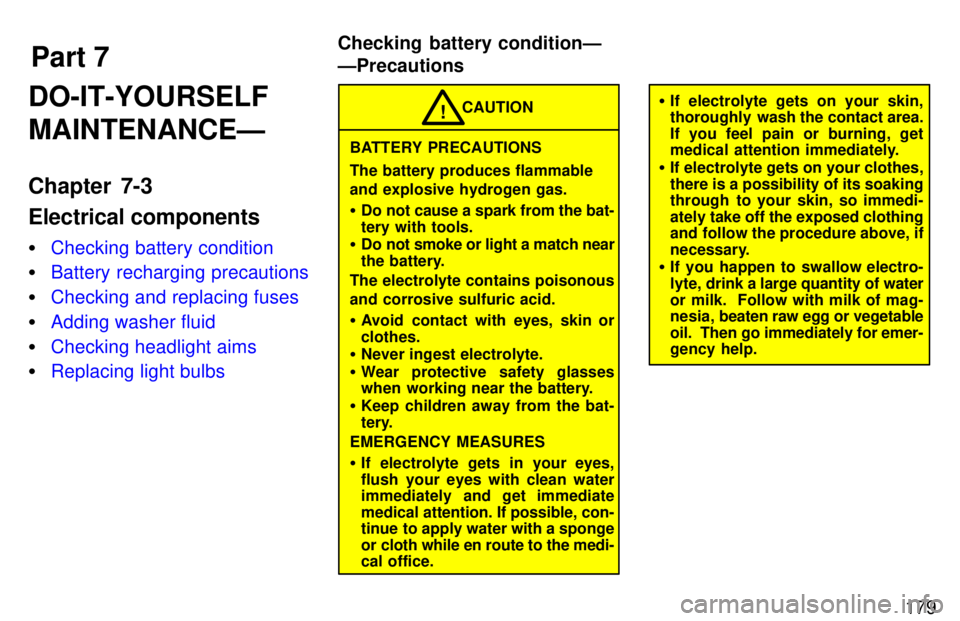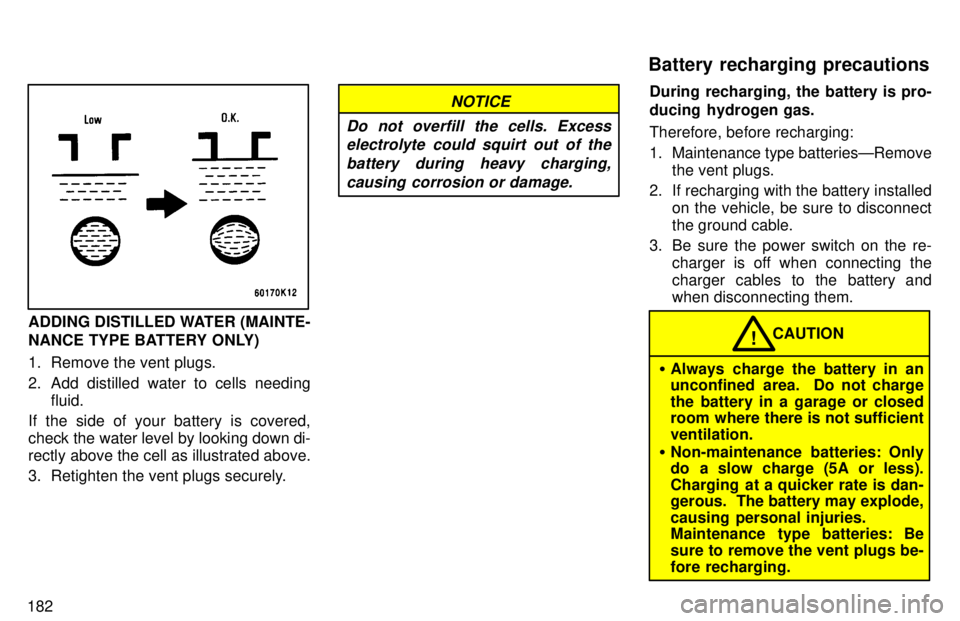1997 TOYOTA RAV4 charging
[x] Cancel search: chargingPage 74 of 198

72
(a) Brake System Warning Light This light has the following functions: Parking brake reminder
If this light is on, make sure the parking
brake is fully released. The light should go
off.
Low brake fluid level warning
If this light comes on and stays on while
you are driving, slowdown and pull off the
road. Then stop the vehicle carefully.There maybe a problem somewhere in
the brake system. check the fluid level of
the see-through reservoir.
To make sure the parking brake has not
caused the warning light to come on,
check to see that the parking brake is fully
released.
If the brake fluid level is low...
At a safe place, test your brakes by start-
ing and stopping. � If you judge that the brakes still work
adequately, drive cautiously to yournearest dealer or shop for repairs.
� If the brakes are not working, have the
vehicle towed in for repairs. (For tow-
ing information, see Part 4.)
It is dangerous to continue driving
normally when the brake fluid level
is low. CAUTION
!
If the brake fluid level is correct...
Have the warning system checked by
your Toyota dealer. (b) Seat Belt Reminder Light and Buzzer
Once the ignition key is turned to ONº or
STARTº, the reminder light and buzzer
come on if the driver's seat belt is not fas-
tened. Unless the driver fastens the belt,
the light stays on and the buzzer stops af-
ter about 4 to 8 seconds.
(c) Discharge Warning Light
This light warns that the battery is being discharged.
If it comes on while you are driving, there
is a problem somewhere in the charging system.
The engine ignition will continue to oper-
ate, however, until the battery is dis-
charged. Turn off the air conditioning,
blower, ra dio, ect., and drive directly to the
nearest Toyota dealer or repair shop.
Page 134 of 198

134
Do not connect it to or near any part that moves when the engine is cranked.
When making the connections, to
avoid serious injury, do not lean over the battery or accidentally let
the jumper cables or clamps touchanything except the correct battery
terminals or the ground.CAUTION
!
5. Start your engine in the normal way. After starting, run it at about 2000 rpm
for several minutes with the accelera- tor pedal lightly depressed. 6. Carefully disconnect the cables in the
exact reverse order: the negative
cable and then the positive cable.
7. Carefully dispose of the battery cover clothsÐthey may now contain sulfuricacid.
8. If removed, replace all the battery vent plugs.
If the cause of your battery discharging is
not apparent (for example, lights left on), you should have it checked. If your engine stalls while driving
0
1. Reduce your speed gradually, keeping
a straight line. Move cautiously off the
road to a safe place.
2. Turn on your emergency flashers.
3. Try starting the engine again.
If the engine will not start, see If your ve-
hicle will not startº.
If the engine is not running, the
power assist for the brakes and
steering will not work so steering
and braking will be much harder
than usual. CAUTION
!
If your engine stalls while driving
Page 175 of 198

Part 7Checking battery conditionÐ ÐPrecautions
179
DO-IT-YOURSELF MAINTENANCEÐ
Chapter 7-3 Electrical components �
Checking battery condition
�Battery recharging precautions
�Checking and replacing fuses
�Adding washer fluid
�Checking headlight aims
�Replacing light bulbs
BATTERY PRECAUTIONS The battery produces flammable and explosive hydrogen gas. �
Do not cause a spark from the bat-
tery with tools.
� Do not smoke or light a match near
the battery.
The electrolyte contains poisonous
and corrosive sulfuric acid. � Avoid contact with eyes, skin or clothes.
� Never ingest electrolyte.
� Wear protective safety glasses
when working near the battery.
� Keep children away from the bat-
tery.
EMERGENCY MEASURES � If electrolyte gets in your eyes,
flush your eyes with clean water
immediately and get immediate
medical attention. If possible, con-
tinue to apply water with a sponge
or cloth while en route to the medi- cal office. CAUTION
!�
If electrolyte gets on your skin,
thoroughly wash the contact area.
If you feel pain or burning, get
medical attention immediately.
� If electrolyte gets on your clothes,
there is a possibility of its soaking
through to your skin, so immedi- ately take off the exposed clothing
and follow the procedure above, if
necessary.
� If you happen to swallow electro-
lyte, drink a large quantity of water
or milk. Follow with milk of mag-
nesia, beaten raw egg or vegetable
oil. Then go immediately for emer-
gency help.
Page 177 of 198

181
CHECKING BY THE FLUID LEVEL
LINES (MAINTENANCE TYPE BAT-
TERY ONLY)
The fluid (electrolyte) level must be be-
tween the upper and lower lines.
When checking the fluid level, look at all six cells, not just one or two.
If the level is lower than the lower line, add
distilled water. (See ADDING DIS-
TILLED WATERº.)CHECKING BY THE HYDROMETER Check the battery condition by the
hydrometer color. Maintenance type batteryHydrometer color
ConditionType AType BCondition
GREENBLUEGood
DARKWHITECharging necessary. Have battery checked by
your Toyota dealer.
CLEAR or LIGHT YELLOWREDAdd distilled water*
*: See ADDING DISTILLED WATERº. Non-maintenance battery
Hydrometer color
ConditionType AType BCondition
GREENBLUEGood
DARKWHITECharging necessary. Have battery checked by
your Toyota dealer.
CLEAR or LIGHT YELLOWREDHave battery checked by
your Toyota dealer.
NOTICE
Do not refill the battery with water.
Page 178 of 198

182
ADDING DISTILLED WATER (MAINTE-
NANCE TYPE BATTERY ONLY)
1. Remove the vent plugs.
2. Add distilled water to cells needingfluid.
If the side of your battery is covered,
check the water level by looking down di-
rectly above the cell as illustrated above.
3. Retighten the vent plugs securely.
NOTICE
Do not overfill the cells. Excess electrolyte could squirt out of the
battery during heavy charging,causing corrosion or damage.During recharging, the battery is pro-
ducing hydrogen gas. Therefore, before recharging:
1. Maintenance type batteriesÐRemove the vent plugs.
2. If recharging with the battery installed on the vehicle, be sure to disconnect the ground cable.
3. Be sure the power switch on the re- charger is off when connecting the
charger cables to the battery and
when disconnecting them.
�Always charge the battery in an
unconfined area. Do not charge
the battery in a garage or closed
room where there is not sufficient ventilation.
� Non-maintenance batteries: Only
do a slow charge (5A or less).
Charging at a quicker rate is dan-
gerous. The battery may explode,
causing personal injuries.
Maintenance type batteries: Be sure to remove the vent plugs be-fore recharging. CAUTION
!
Battery recharging precautions
Page 192 of 198

196
Oil grade:
API SH, Energy-Conserving IIº mul-
tigrade engine oil or ILSAC multigrade en-
gine oil is recommended. Recommended oil viscosity (SAE):
COOLING SYSTEM
Total capacity, L (qt., Imp., qt.):
Manual Transmission 8.0 (8.5, 7.0)
Automatic transmission
7.7 (8.1, 6.8) Coolant type:
With ethylene-glycol antifreeze (Do not use alcohol type.)
BATTERY Open voltage* at 20 �C (68 �F):
12.6 '12.8 V Fully charged
12.2 '12.4 V Half charged
11.8 '12.0 V Discharged
*: Voltage that is checked 20 minutes after
the key is removed with all the lights
turned off Charging rates: 5 A max.
CLUTCH
Pedal freeplay, mm (in.):
5' 15 (0.2 '0.6)
Fluid type: SAE J1703 or FMVSS No. 116 DOT 3
MANUAL TRANSAXLE
Oil capacity, L (qt., Imp. qt.): Two-wheel drive models 3.9 (4.1, 3.4)
Four-wheel drive models
5.0 (5.3, 4.4) Oil type:
Two-wheel drive models
Multipurpose gear oil API GL-4 or GL-5
Four-wheel drive models
Multipurpose gear oil API GL-5
Recommended oil viscosity:
SAE 75W-90
AUTOMATIC TRANSAXLE Fluid capacity (drain and refill), L (qt., Imp. qt.): Two-wheel drive models Up to 3.3 (3.5, 2.9)
Four-wheel drive models Up to 7.0 (7.4, 6.2)
Fluid type:
Two-wheel drive models Automatic transmission fluid D-II or DEXRON [
III (DEX
RON [
II)
Four-wheel drive models Toyota automatic transaxle
fluid Type T or equivalent
Page 195 of 198

199
Engine compartment (U.S.A.) Fuses (type A) 1 AM2 20A: Multiport fuel injection sys-
tem/sequential multiport fuel injection
system, charging system
2 DOME 15A: Personal lights, open door
warning light, clock 3 EFI 15A: Multiport fuel injection sys-
tem/sequential multiport fuel injection system 4 HAZ-HORN 15A: Emergency flashers,
horns
5 ALT-S 5A: Charging system
6 SPARE 15A: Spare fuse
7 SPARE 7.5A: Spare fuseEngine compartment (Canada) 8 H-LP LH 15A: Left-hand headlight
9 H-LP RH 15A: Right-hand headlight
10 DRL 7.5A: Daytime running light sys-
tem
11 H-LP LH-L 10A: Left-hand headlight
(low beam)
12 H-LP RH-L 10A: Right hand head-
light (low beam)
13 H-LP LH-H 10A: Left-hand headlight
(high beam)
14 H-LP RH-H 10A: Right-hand healight
(high beam)Engine compartment
15 TAIL 10A: Tail lights, parking lights, li-
cense plate lights, interior lights
16 GAUGE 10A: Gauges and meters,
service reminder indicators (except dis-
charge and open door warning lights),
back-up lights, air conditioning system,
power windows, rear window defogger,
center differential lock system, electroni-
cally controlled automatic transmission system
17 TURN 7.5A: Turn signal lights
18 CIG & RAD 15A: Cigarette lighter,
clock, car audio system, power rear view mirrors
Fuses